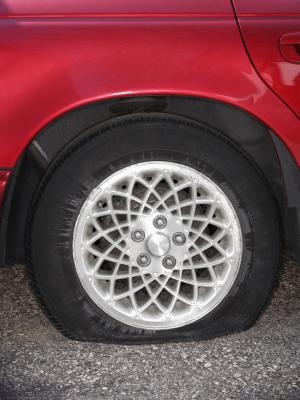
Flat tires can be caused by sharp objects penetrating the inner seal. Tires will also go flat if they are not changed when they are damaged or worn. If they wear through, they may blow out while driving. Objects that penetrate the tire will cause it to lose air until the vehicle's tire flattens. There are repairs that can be done if the tire is not seriously damaged including the combination of a seal and plug.
Remove the tire from the vehicle. The tire must be raised off the surface for removal. Use a jack or an industrial lift to raise the vehicle. Use a torque wrench, if available, for the easiest removal of the lug nuts. A ratchet or lug wrench can also be used to remove the tire. After the lug nuts are removed, the tire can be removed from the car. Fully deflate the tire.
Separate the tire from the rim. Tire separation can be done with the use of tire irons but it can be difficult. The tires can be removed from the rim at a service garage for $5 to $10 per tire. Any patch made on a tire without the removal of the tire from the rim is incomplete because you cannot evaluate the amount of damage sustained by the inner seal of the tire.
Locate the puncture. Remove the object from the tire if it is still penetrating it.
Use a solid-edged object to push through the hole to identify the contour of the puncture. Apply a small amount of tire-mounting lubricant to the puncture to help plug the damage.
Push the plug through the hole from the inside of the tire toward the outside surface until it is a flush with the inner liner of the tire. The plug should be pushed through the tire in the same way the puncture was created. The plug will keep moisture and other debris from migrating into the tire and rusting the steel belts and body cord.
Clean the tire's inner liner of dirt and foreign material around the plug of dirt. Apply the seal to the inner liner to complete air containment. This will prevent air from escaping the tire.
Place the tire on the rim and fill it with air to the appropriate pressure. Listen for any evidence of escaping air. Mount the tire back on the vehicle and drive around for a few minutes to ensure there is no loss of air. If no air is escaping, the patch is successful.